Featured Comment:
“I’ve made this dish several times now and everyone’s enjoyed it a great deal. It’s delicious and a wonderful alternative to the usual fare.”
– Ellen
What is Chirashizushi?
Chirashizushi is a traditional type of sushi made by topping sushi rice with a variety of seafood, vegetables, and egg. The word “chirashi” means “scattered” and refers to the ingredients scattered over the top of the sushi rice.
It’s usually served in a bowl or on a plate, either as one large impressive display or as cute, decorative individual portions. It’s very colorful and completely different to other kinds of sushi.
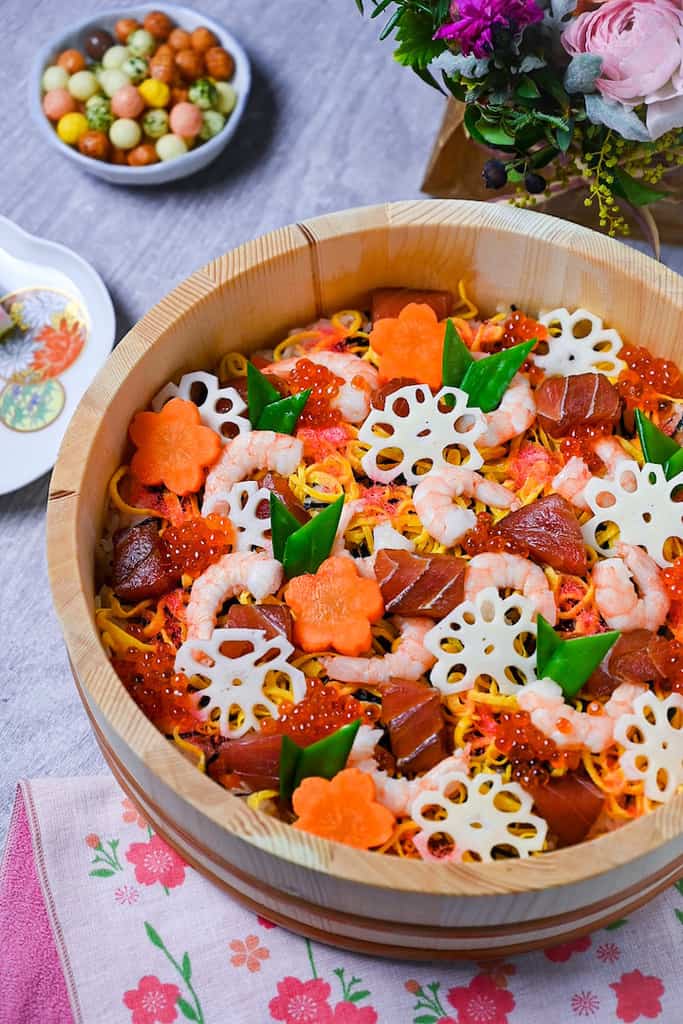

How I Developed This Recipe
When I came up with this recipe for chirashizushi, a dish typically associated with celebrations like the Girl’s Festival, I knew it had to be both a visual treat and delicious. Chirashizushi is all about celebration, so I made sure to choose ingredients that would create a colorful and beautiful presentation.
I chose each ingredient not only for its vibrant color but also for its ability to contribute to the overall flavor profile and texture of the dish.
This chirashizushi is a feast for the eyes as well as the palate. I hope you’ll enjoy it at your celebrations and parties, where it’ll look great and taste even better!
Chirashizushi and Hinamatsuri (Girl’s Festival)
In Japan, March 3rd is a special day called “hinamatsuri” (ひな祭り), which can be translated as “girl’s festival.” It is traditionally celebrated to pray for girls’ healthy growth and happiness. FYI, the boy’s festival is held on the 5th of May and is known as “Kodomo no Hi” or “Children’s Day.”

Chirashizushi is usually eaten on Girl’s Day because of its colorful and festive appearance, not to mention that it is made with many auspicious ingredients from the mountains and sea.
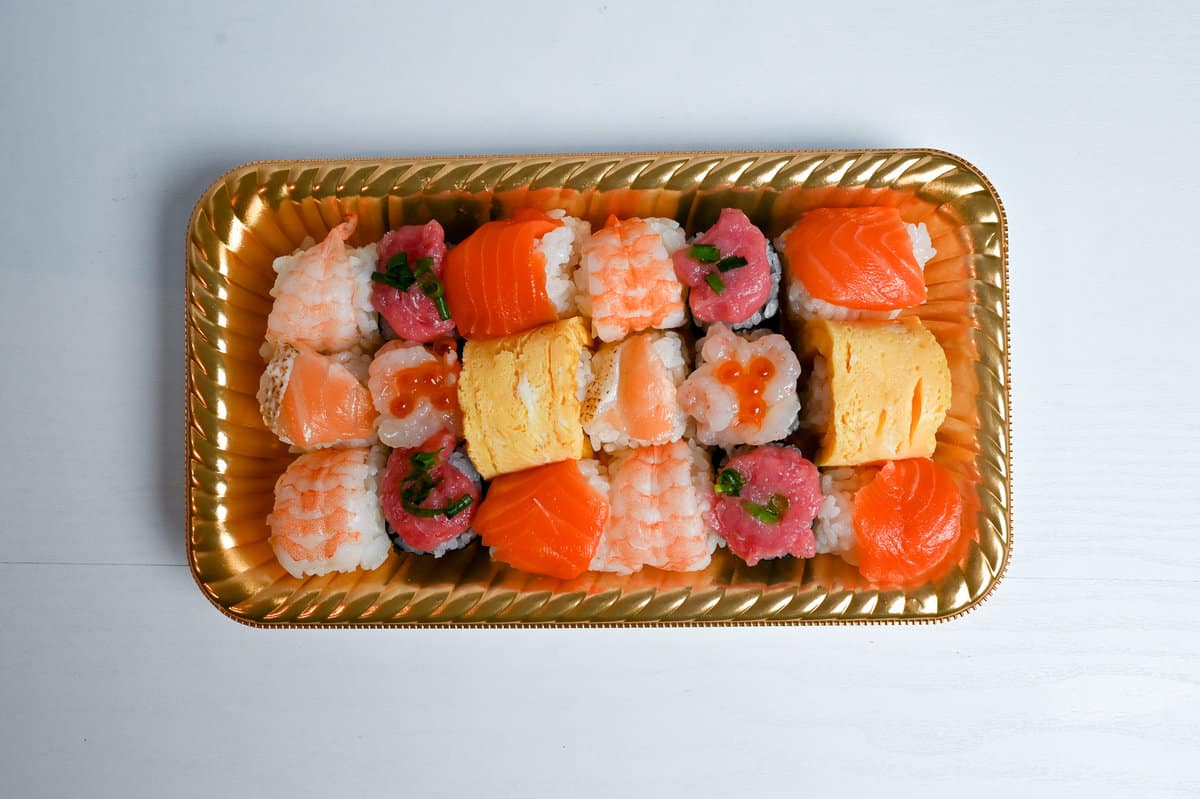
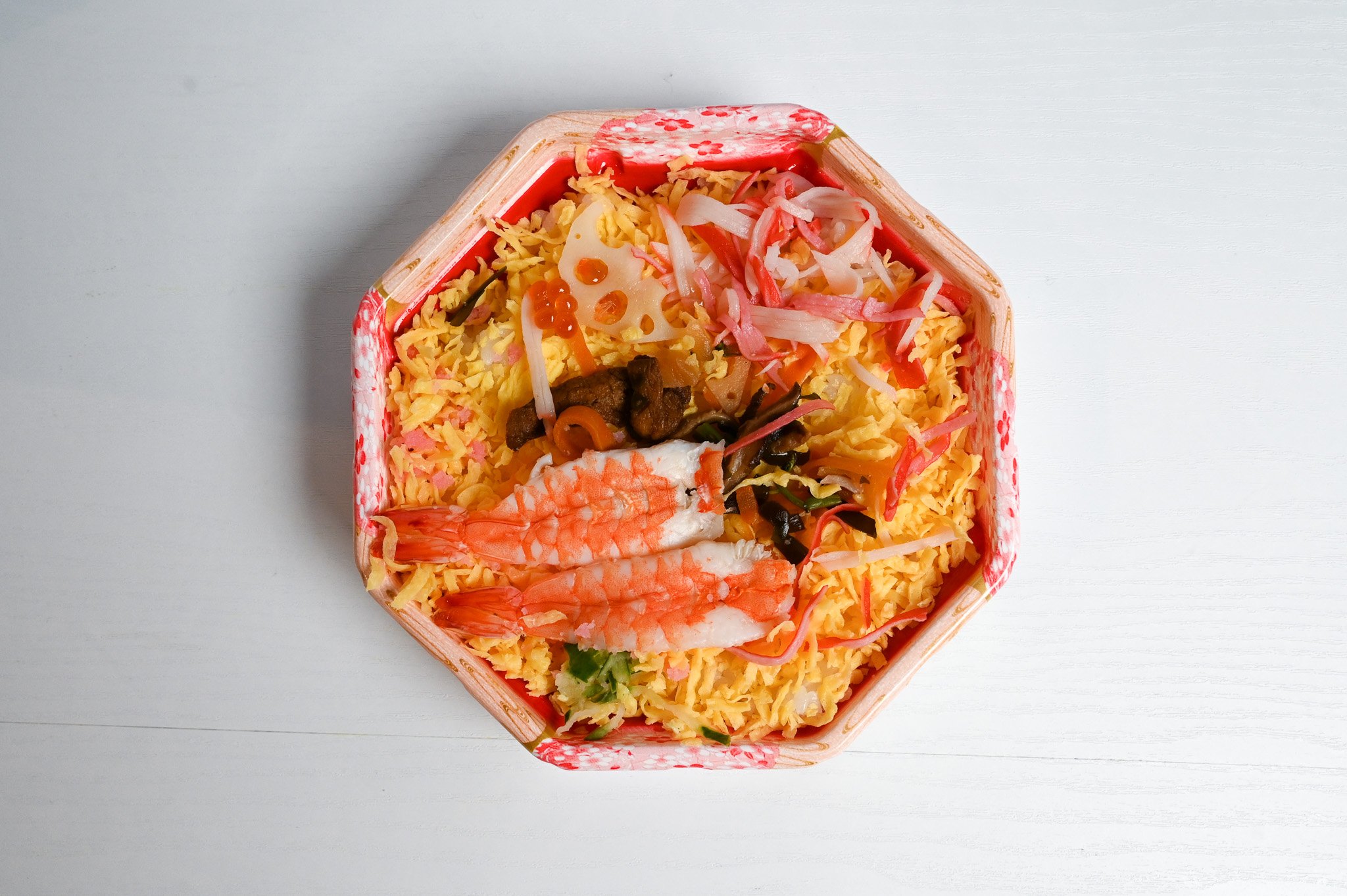
You can find many Temarizushi and Chirashizushi in Japanese supermarkets like above on March 3. Other iconic girl’s day foods include:
- Hina Arare (rice snacks): They pray for children’s growth and reflect the spirit of frugality. The shape differs between Eastern and Western Japan.
- White Sake, Sweet Sake, Peach Blossom Wine: Originally, people drank peach blossom wine for longevity, but in the Edo period (1603-1868), white wine became the norm. The non-alcoholic sweet sake called “amazake” is popular with children nowadays.
- Hishimochi: To wish for healthy growth, green rice cakes filled with mugwort (to ward off bad luck), white rice cakes filled with water chestnuts (to promote prosperity), and red/pink rice cakes filled with kuchinashi (to ward off evil) are piled on top of each other. Modern hishimochi is usually colored with food coloring.
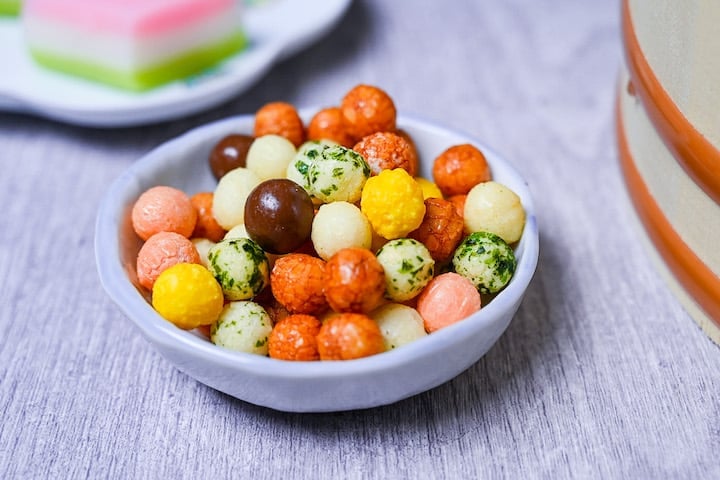
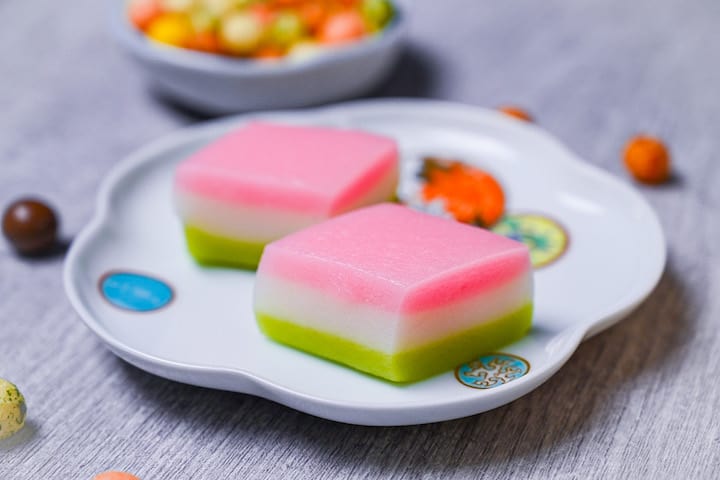
Common & Alternative Ingredient Ideas
Chirashizushi is an ideal food for Girl’s Day, not only because of its gorgeous appearance. The colorful ingredients that make chirashizushi also have different meanings and are supposed to bring good luck.
Common ingredients:
- Shrimp: Because of its curved back, it often means longevity and good health. The reddish color is also supposed to ward off evil. Moreover, because shrimps repeatedly shed their skin and grow larger, it refers to growth and success.
- Lotus roots (Renkon): The lotus root has many holes, and because of this feature, it is said to have a ‘good outlook’ and to be able to see the future. Lotus root is also included in many New Year’s dishes and is generally considered a lucky ingredient in Japanese culture. Tip: If you cut small triangles between each hole on a slice of lotus root, you can make a flower shape!
- Beans: In Japanese, beans are called “mame” (豆). But actually, the word “mame” has another meaning! It also means “considerate” or “attentive” in personality. So it is said that including beans in the dish will help girls to grow up with a caring personality.
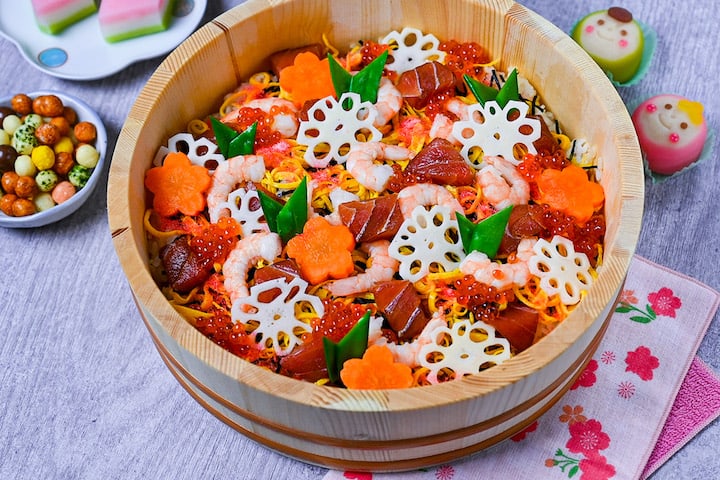
Ingredients I used in this recipe:
- Boiled prawns/shrimps
- Tuna
- Salmon roe (Ikura)
- Shredded egg crepe (Kinshi tamago)
- Lotus root
- Carrot
- Snow peas
- Dried shiitake
- Aburaage (Double fried tofu)
- Sakura denbu (Pink sweet fish powder)
- Kizami nori
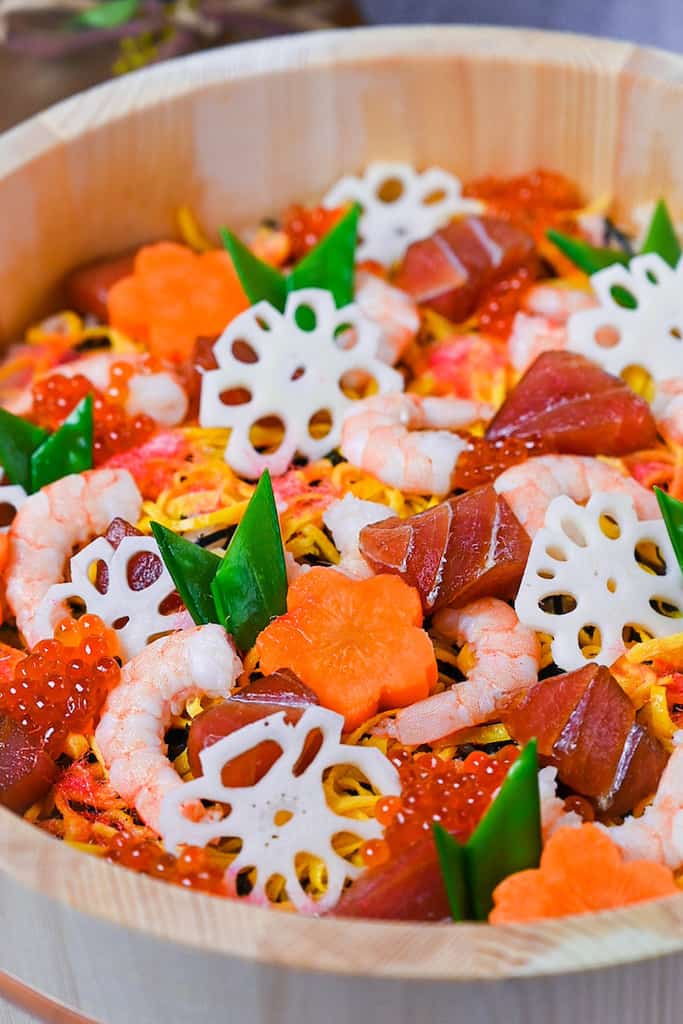
Alternative ingredient ideas:
- Salmon/smoked salmon: If it’s hard to get sashimi-grade raw tuna, you can replace it with raw salmon (must also be sashimi-grade) or smoked salmon. However, most smoked salmon is already flavored and salted, so if you replace tuna with smoked salmon, I suggest omitting the marinating process in my recipe.
- Cucumber: I didn’t include it in my recipe, but it is crunchy and refreshing, so it’s also a popular ingredient in chirashizushi. If you cut them into small cubes or decorative shapes, it will be good for aesthetics.
- Avocado: This is a bit of a modern twist, but everyone knows that sushi and avocado are a great match! It’s the same as cucumber; cut them into small cubes for good presentation!
- Crab: This is a great alternative if it’s easier to get crab than other seafood like tuna or salmon. This works with real crab and imitation crab sticks for an easier and cheaper option. Some Japanese households add crab sticks for easy chirashizushi!
But, don’t be afraid to be creative! I know Japanese cuisine can seem traditional with many rules, but it’s really not the case in Japanese home cooking.
Many home cooks in Japan take advantage of their freedom and get creative with traditional recipes, so don’t be afraid to be creative too and make your own favorite chirashizushi!
Jump to Full Recipe MeasurementsVisual Walkthrough & Tips
Here are my step-by-step instructions for how to make Chirashizushi at home. For ingredient quantities and simplified instructions, scroll down for the Printable Recipe Card below.
If you prefer to watch the process in action, check out my YouTube video of this Chirashi Sushi recipe for a complete visual walkthrough!
1. Prep (Soaking/Marinating)
Start by soaking dried shiitake mushrooms in cold water to rehydrate them. I used 3 small dried shiitake, but 2 medium or 1 large one can be used instead.
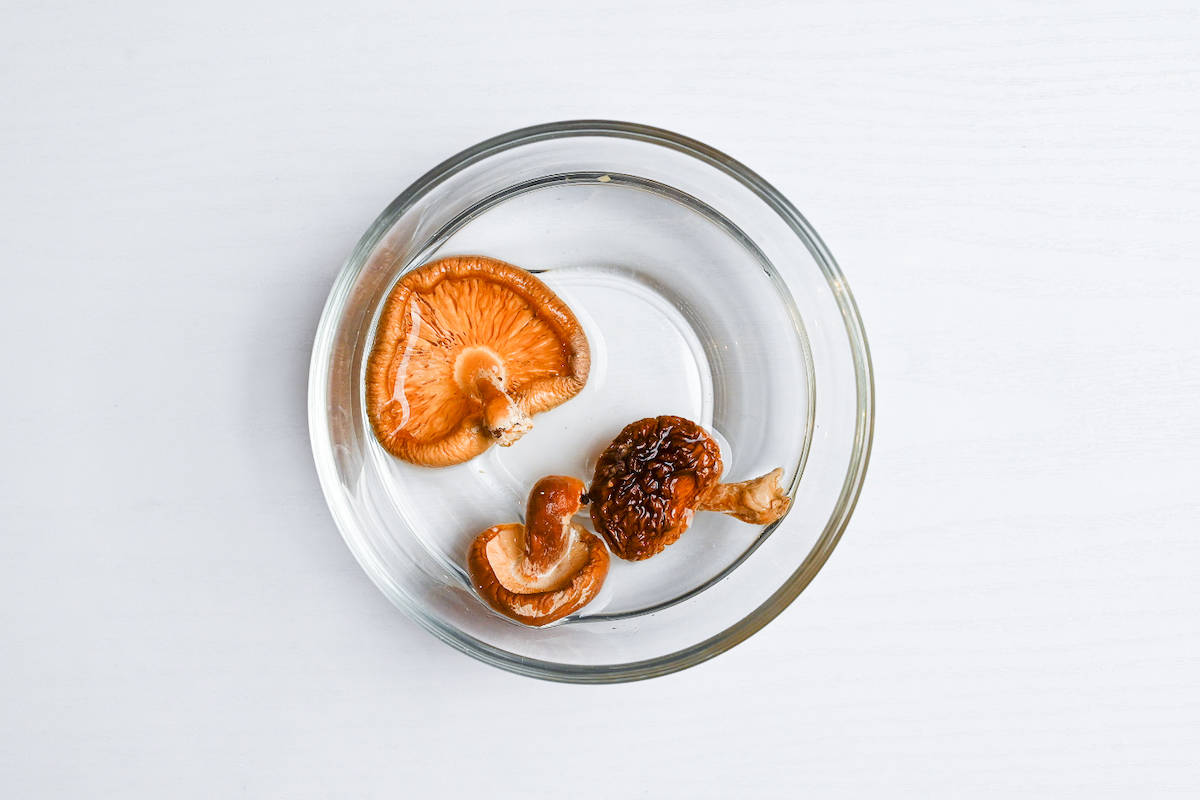
In a small saucepan, add sake and mirin. Boil for 30 seconds to evaporate the alcohol.
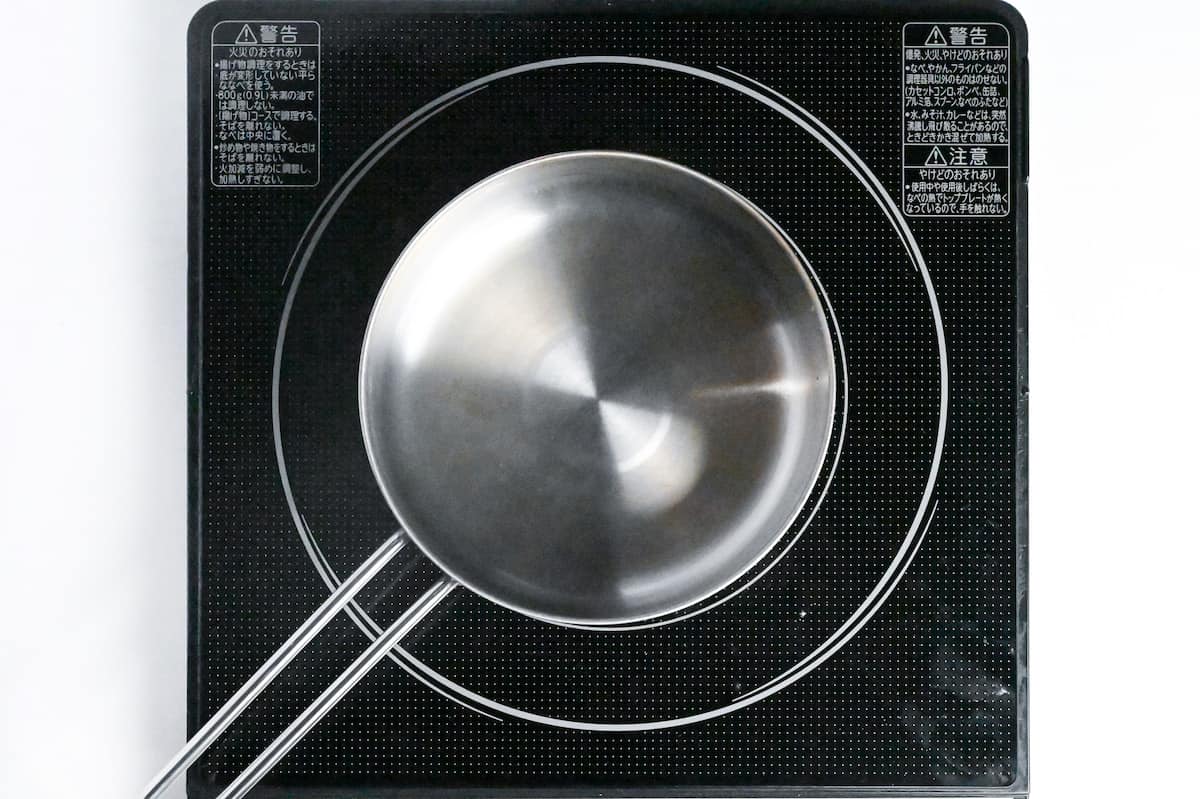
Then turn off the heat. Stir in soy sauce and let the mixture cool for a few minutes.
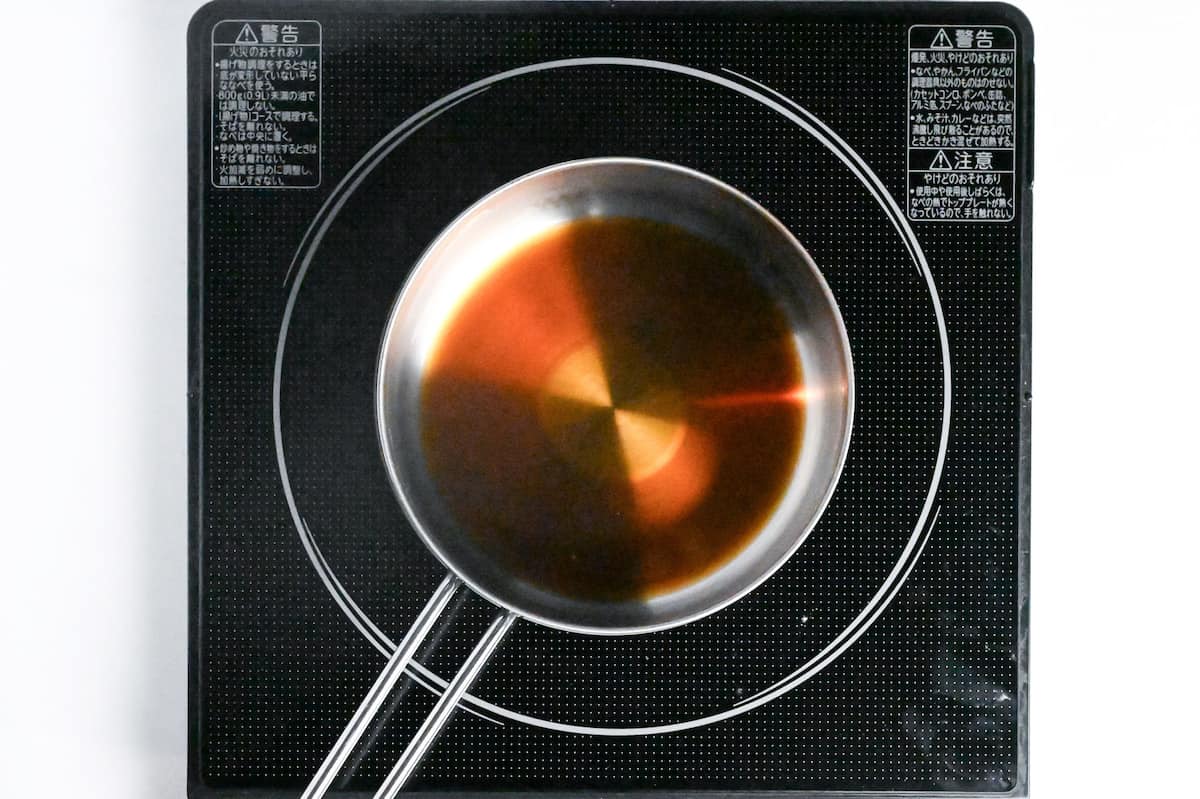
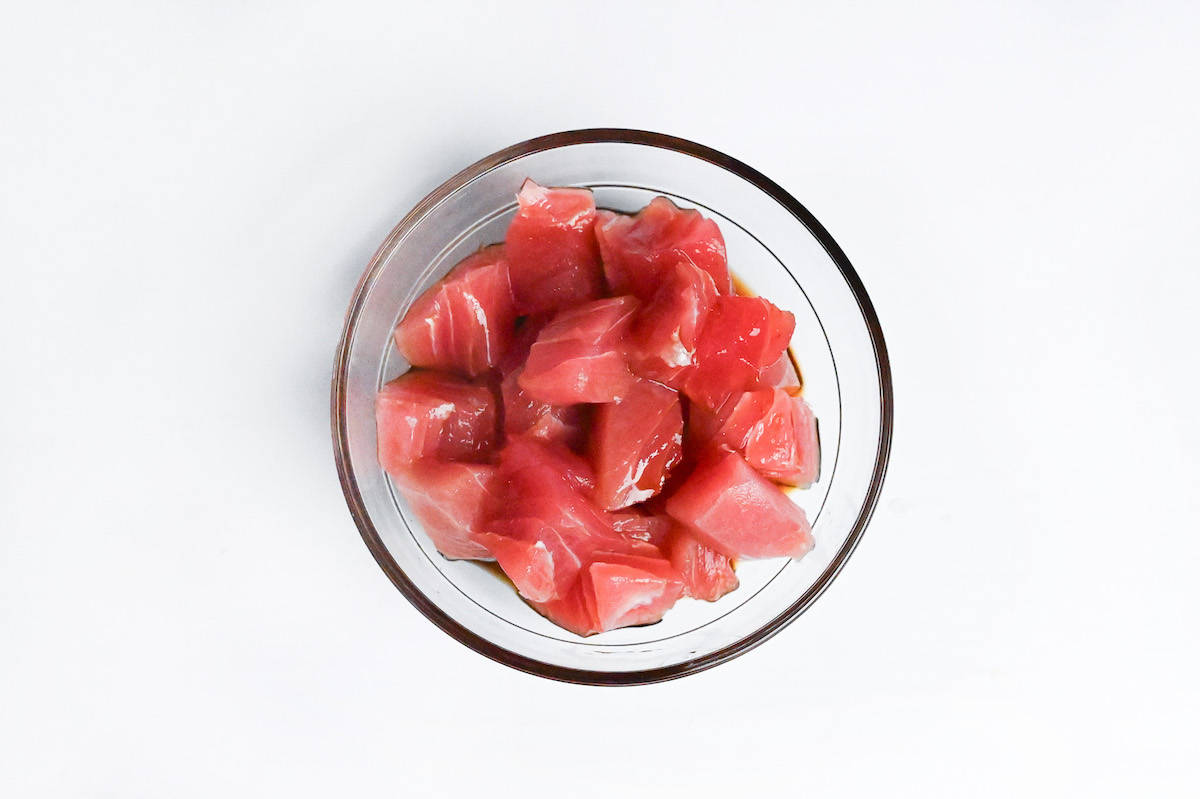
Once the marinade is cool, place cubed tuna in a container. Pour the sauce over the tuna, mix well, cover, and let it marinate until serving time.
Jump to Full Recipe Measurements2. Rice Prep
Once the mushrooms are rehydrated, remove them and thinly slice them. Pour the leftover soaking water (now shiitake dashi) into a pan along with the sliced shiitake, carrots, and fried tofu pouches.
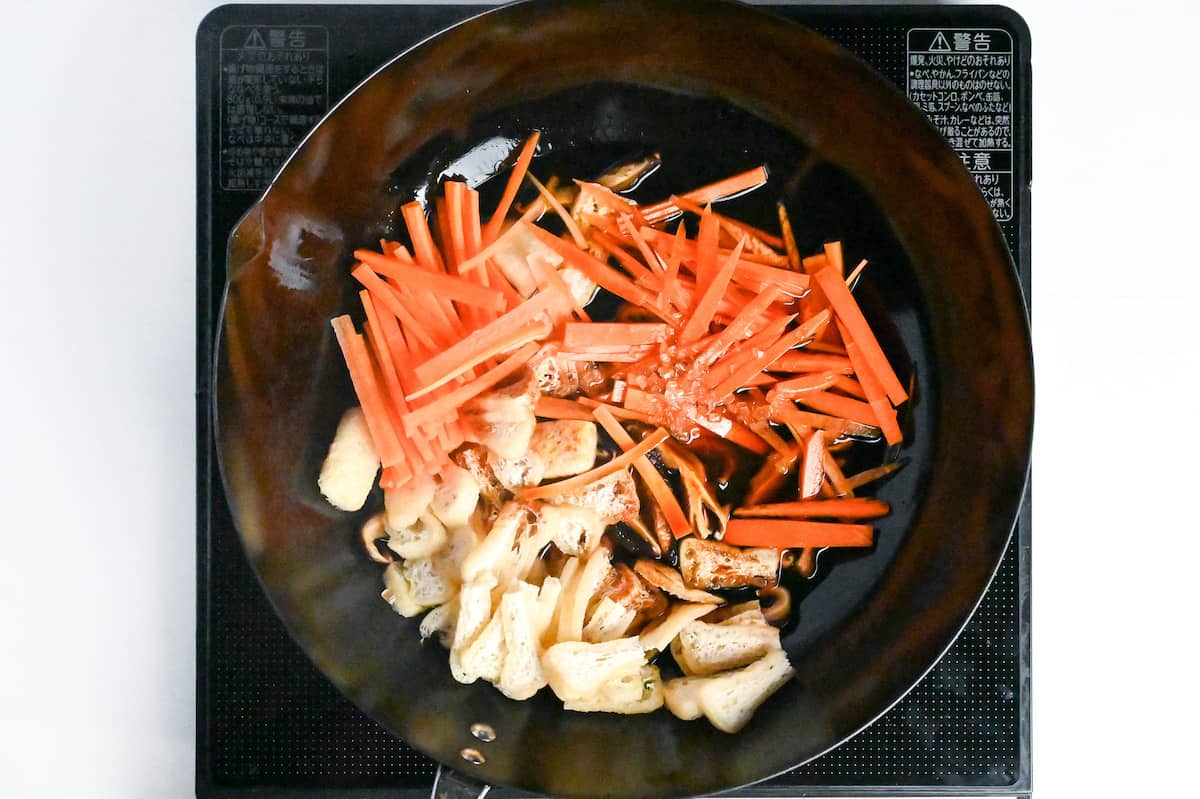
Add sake, sugar, mirin, and soy sauce to the pan.
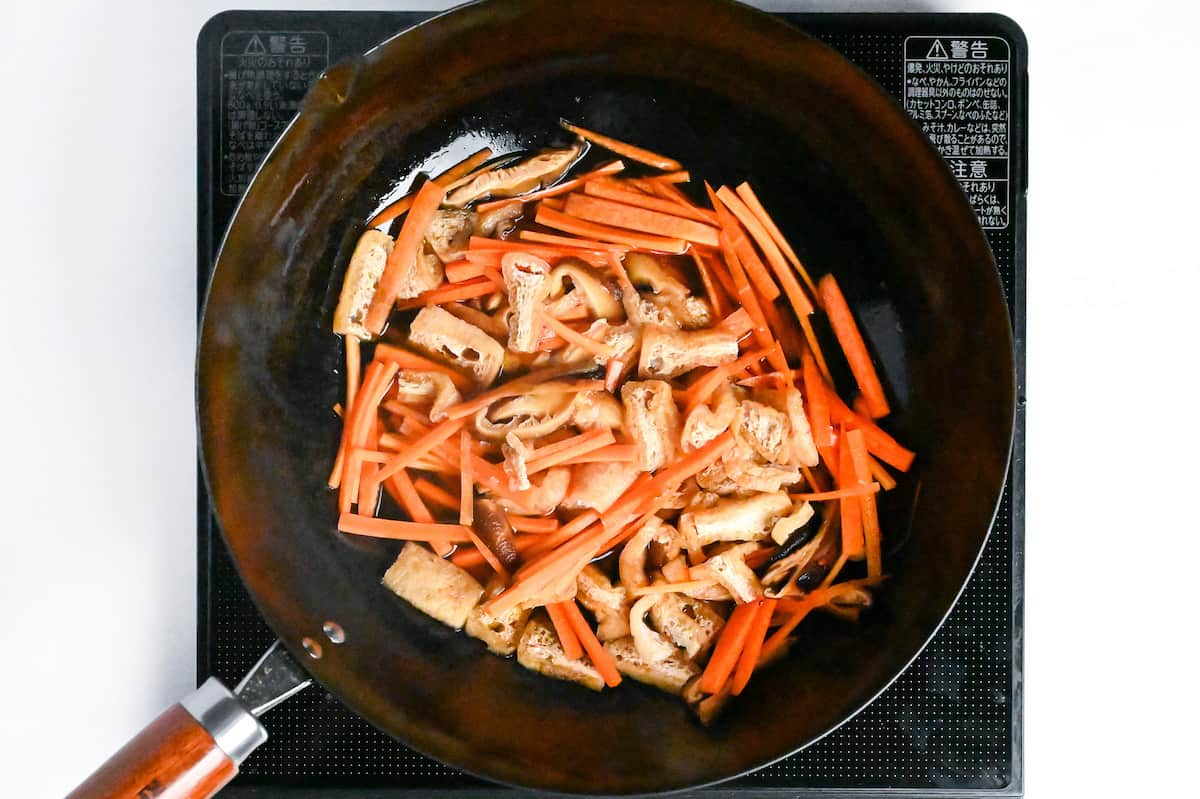
Cook over medium heat until the liquid has evaporated, stirring occasionally to prevent burning.
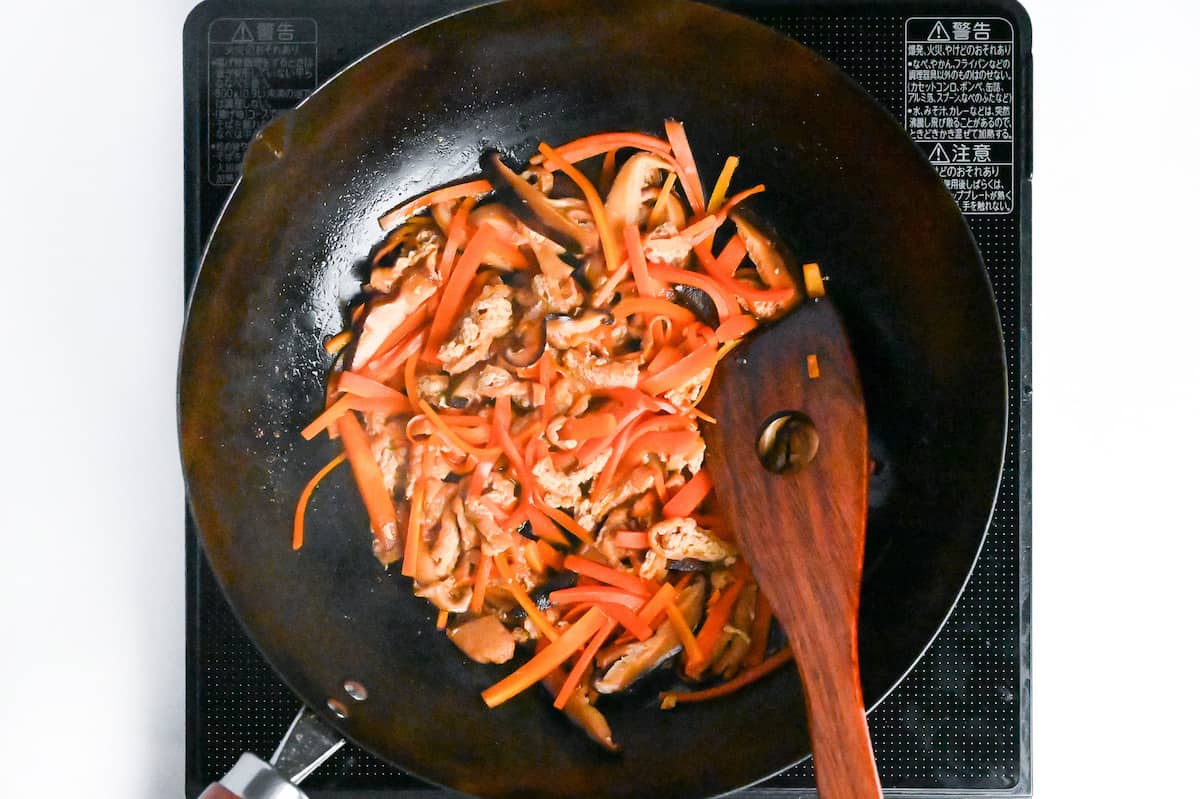
In a small bowl, dissolve sugar and salt in rice vinegar. This is your homemade sushi vinegar.
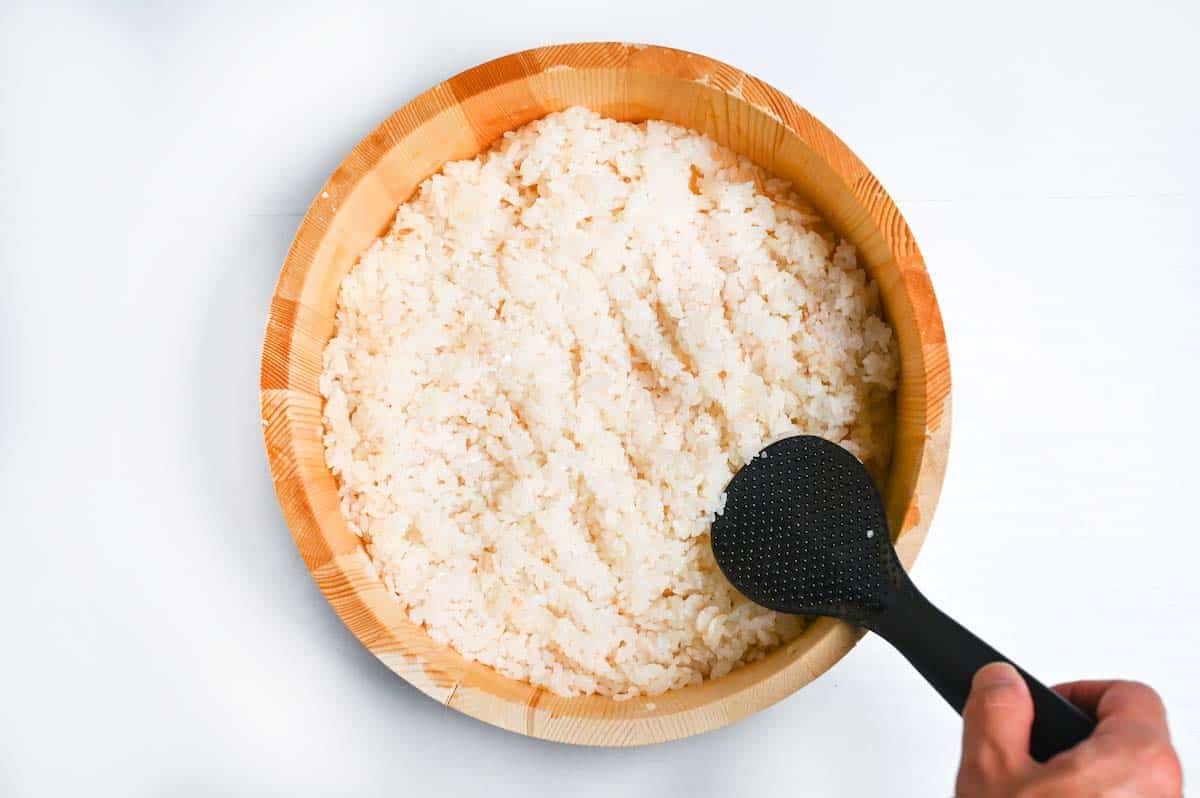
Pour the sushi vinegar over freshly cooked Japanese short-grain rice. Mix thoroughly. Add the cooked shiitake, carrot, and tofu mixture to the rice and mix gently until evenly distributed.
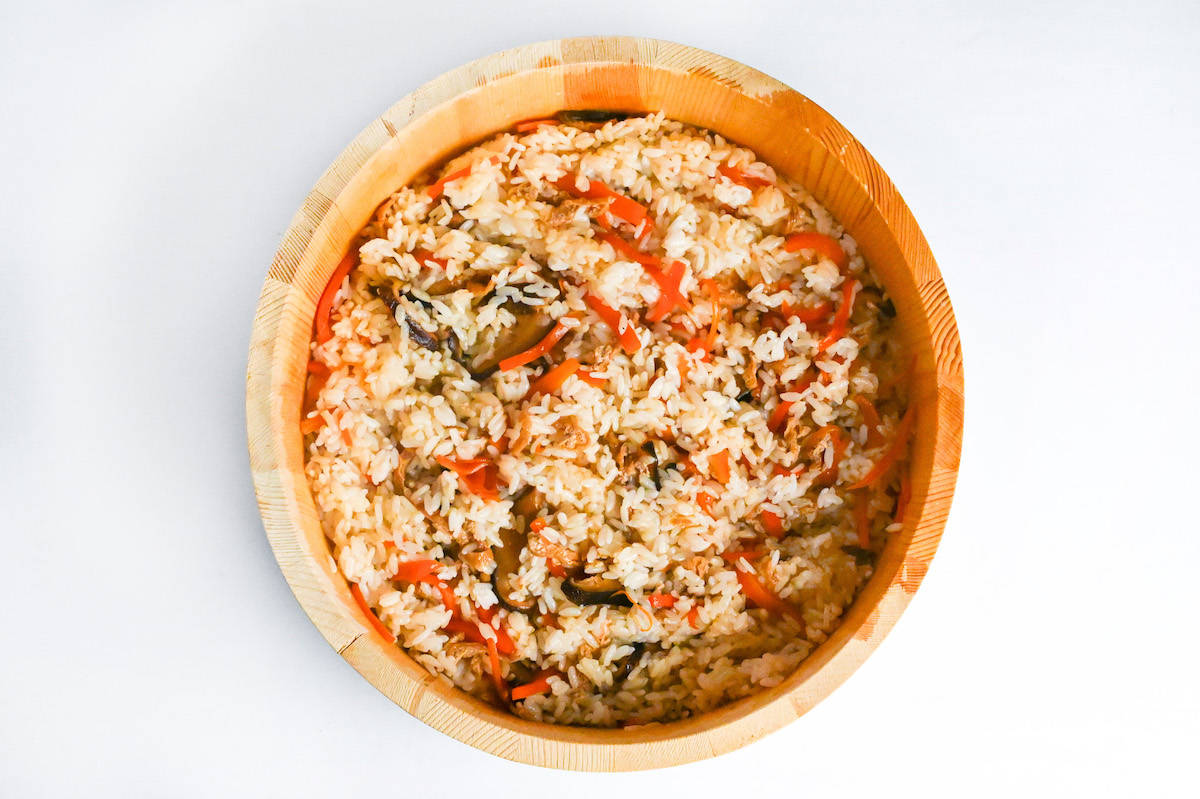
To make Chirashizushi, you will need Japanese short-grain white rice, which is stickier than other varieties and perfect for sushi, onigiri, and other dishes. While a rice cooker is recommended for frequent rice cooking, it is not necessary. Check out my post on how to cook Japanese-style rice on the stove if you do not have a rice cooker.
The cooked rice is then mixed with vinegar, sugar, and salt to make sushi rice. Though these ingredients were originally added to preserve the rice, they also enhance the flavor and complement the fish, making it a win-win situation!
Cover the rice with a damp kitchen towel to prevent it from drying out.
Jump to Full Recipe Measurements3. Kinshi Tamago
Crack medium eggs into a bowl, add salt, and whisk well.
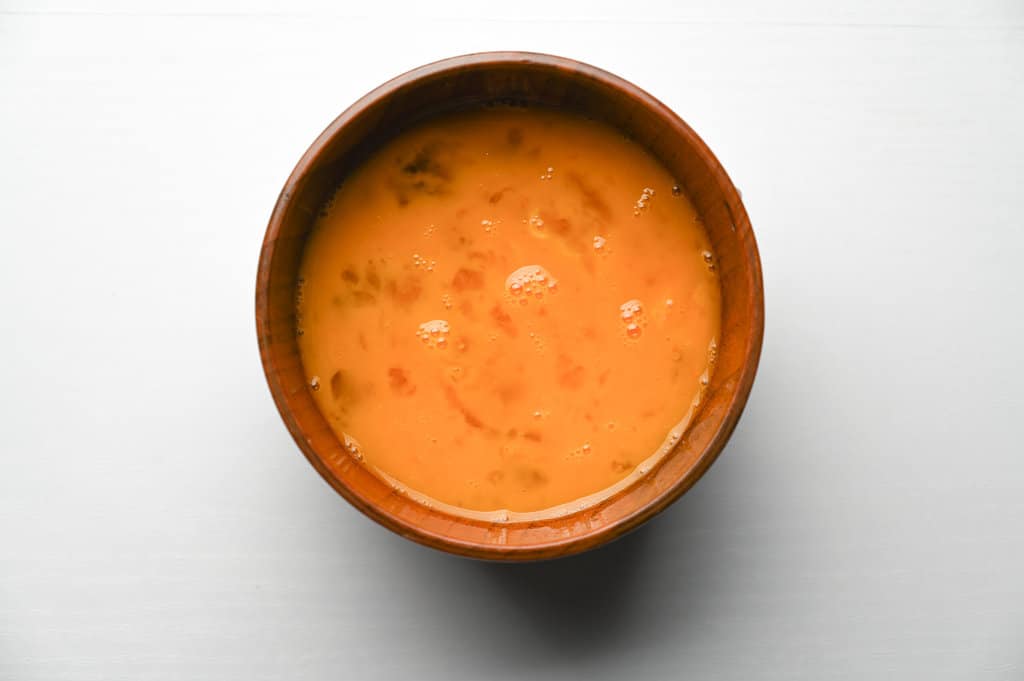
Strain the egg mixture through a sieve into another bowl, whisking until it passes through.
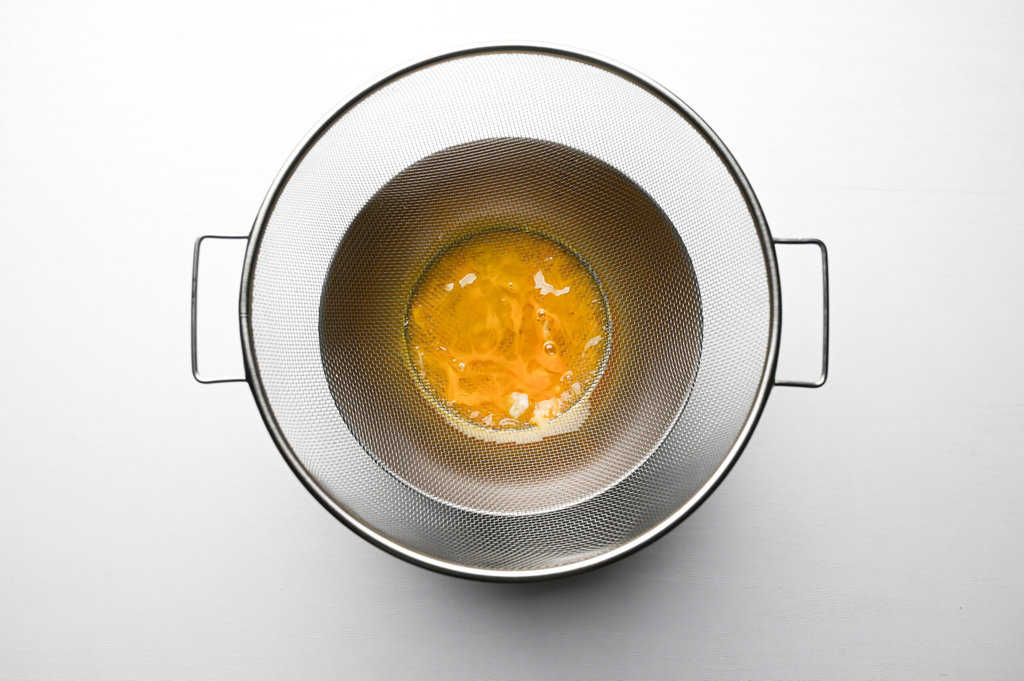
Kinshi tamago is a type of thinly sliced egg crepe. There are three important tips to keep in mind when making kinshi tamago. Pouring the whisked egg through a sieve is the most important tip. If you skip this step, your kinshi tamago may not have a perfect yellow color and may be mottled with bits of white.
Kinshi tamago is an important aspect of Japanese cuisine known for its aesthetic appeal. Alternatively, you can use dashimaki tamago (Japanese rolled omelette) cut into shapes.
Heat a small non-stick frying pan over medium-low heat. Add cooking oil and use a paper towel to spread and remove the excess. Pour a thin layer of egg into the pan to cook. Do this in batches to keep the layers thin.
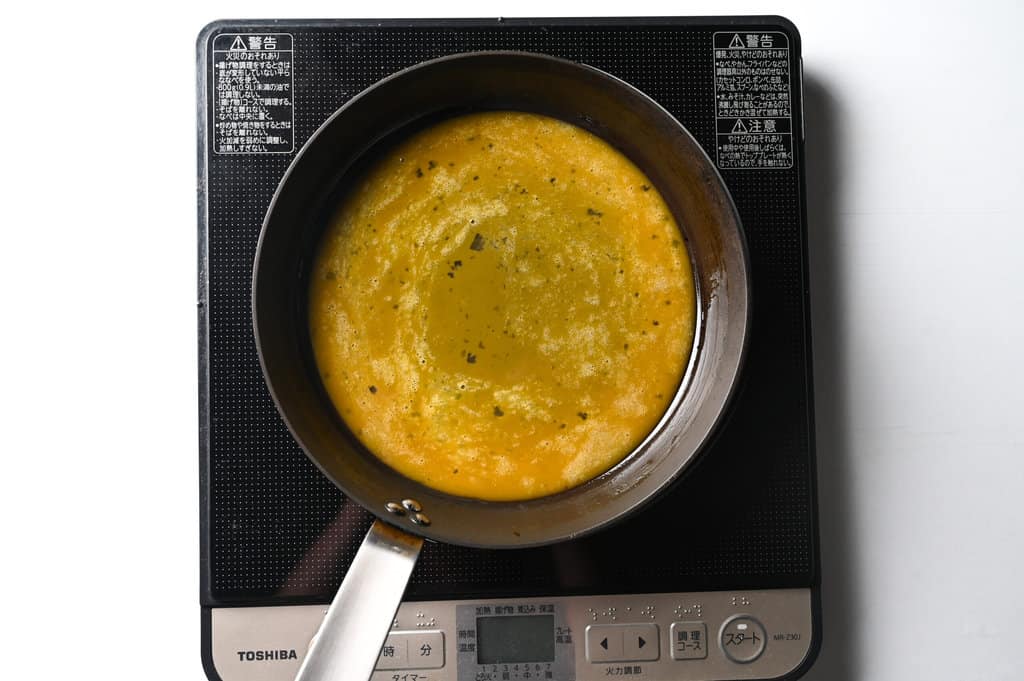
Once the egg is 80% done, peel it out of the pan, transfer it to a chopping board, and roll it up.
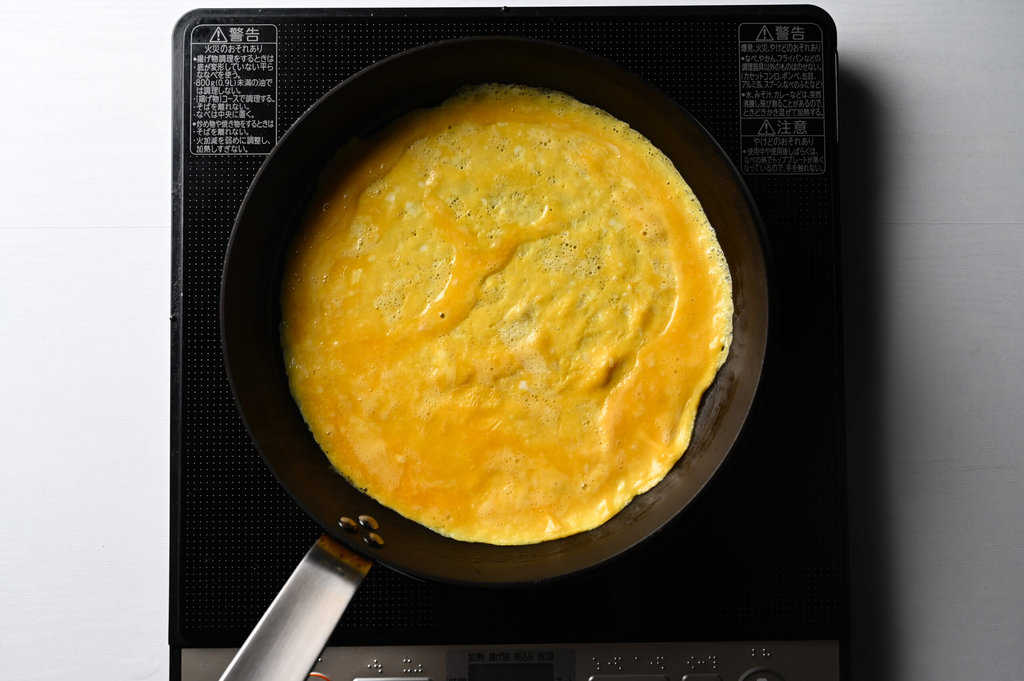
Thinly slice the roll to complete the kinshi tamago. Repeat until all the egg mixture is used.
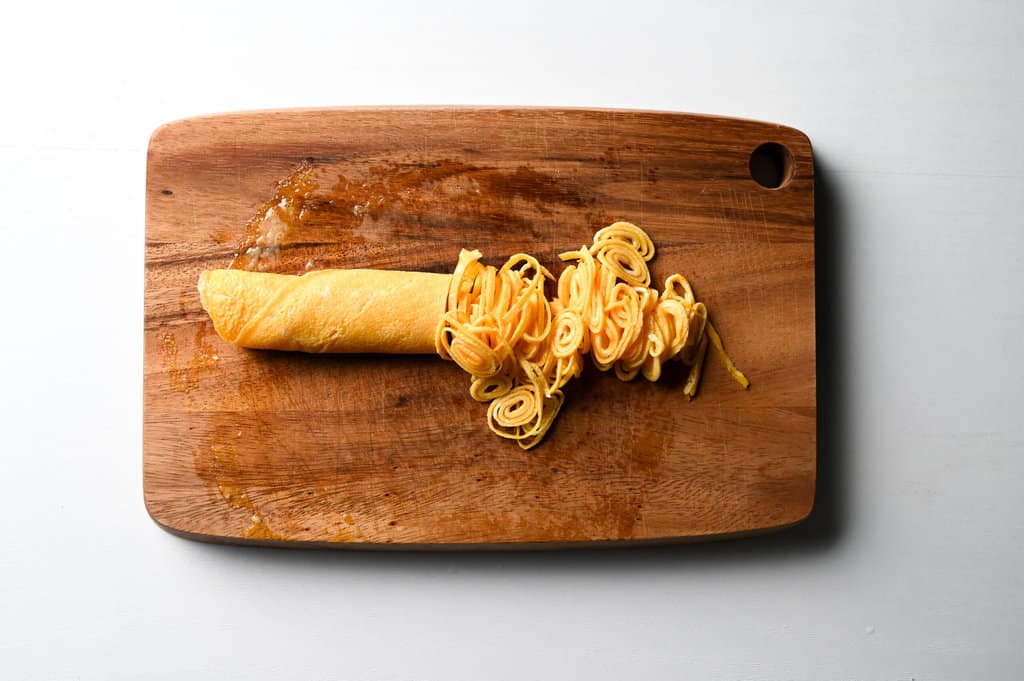
4. Assembly
It’s not like there is a specific rule for the order, but I thought sharing how I layered my chirashizushi would be useful.
So, here is the order from the bottom:
- Rice
- Nori
- Kinshi Tamago
- Prawns, lotus roots, tuna
- Sakura denbu and ikura
- Snow peas
Transfer the seasoned rice into serving bowls. Sprinkle each with 3 tbsp shredded sushi nori seaweed (kizami nori).
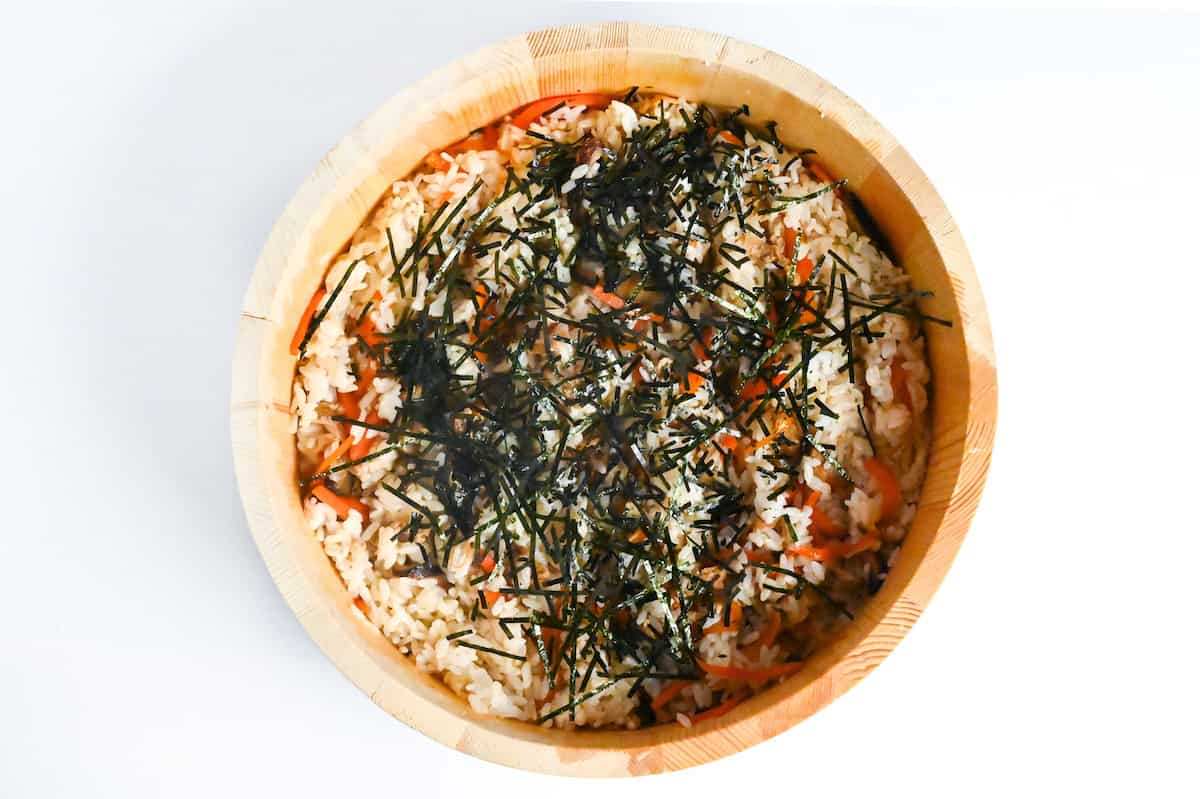
Place kinshi tamago on top of the rice.
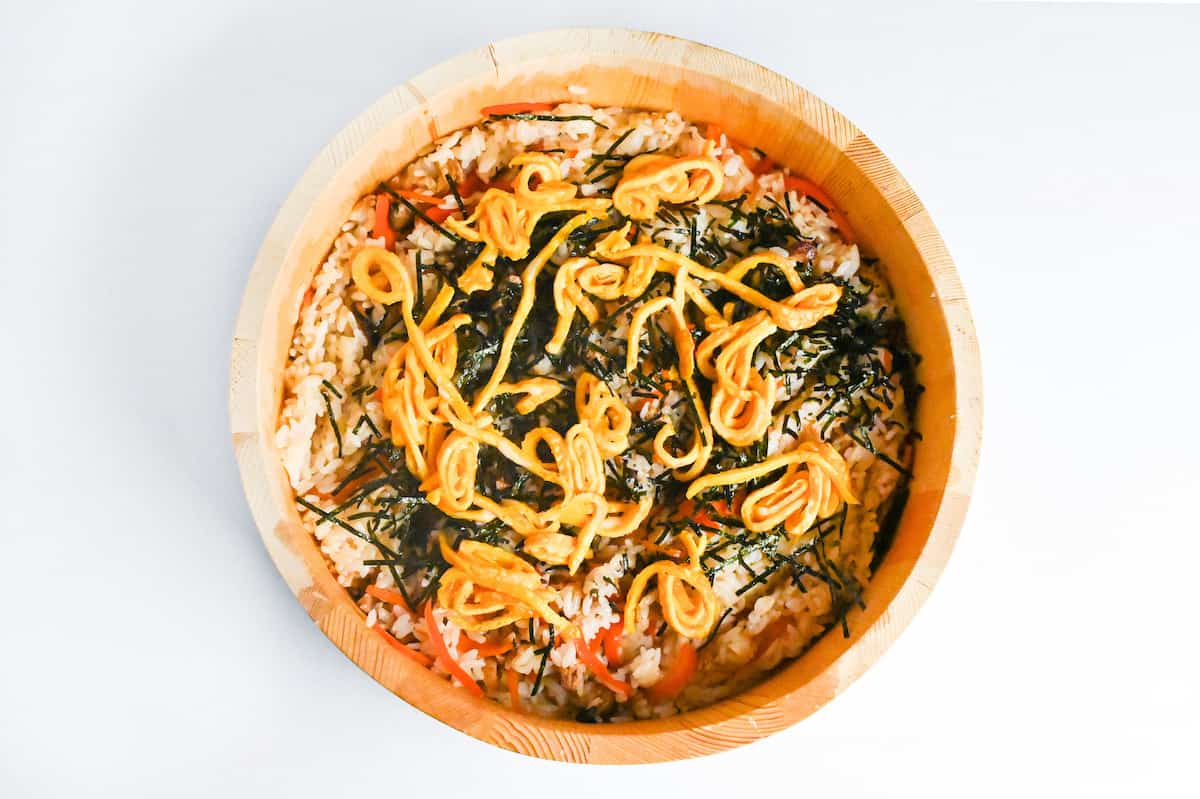
Arrange the marinated tuna, lotus root, shrimp, salmon roe, sweet pink fish powder, and snow peas on top.
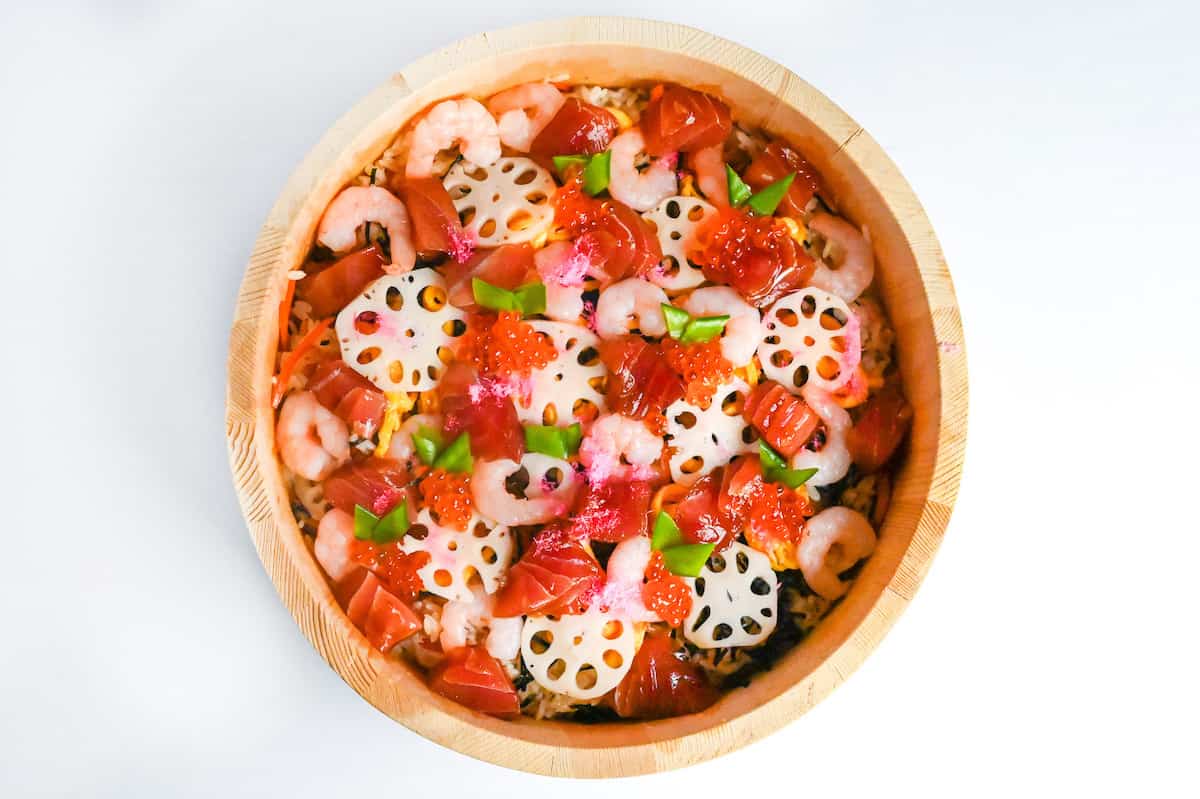
Serve and enjoy your beautifully crafted dish, a feast for both the eyes and the palate!
If you’re in Japan, buying pre-boiled and pre-sliced lotus roots from any supermarket is a great shortcut. However, if you’re living elsewhere and want to prepare raw lotus roots, here’s what you need to do:
- Wash the lotus root.
- Peel the skin with a peeler.
- Thinly slice the lotus root.
- Soak the slices in water with 1 tsp of vinegar (or lemon juice) for about 5 minutes.
- Boil 500ml of water and 1 tsp of vinegar, add the lotus slices, and boil for 1-3 minutes depending on the thickness.
- Drain the water and leave them to cool.
- If you don’t plan to use the lotus roots straight away, marinating them will lengthen their shelf life. Mix 1 tbsp of light brown sugar, 1/2 tbsp of mirin, 2 tbsp of rice vinegar, and 50ml of water in a pan, and boil for 30 seconds. Cool the mixture down and then transfer to a clean container. Add the lotus roots and store them with an airtight lid in the refrigerator.
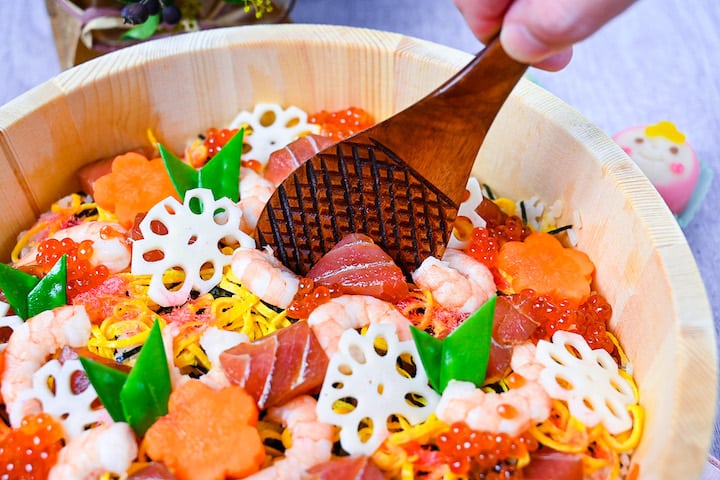
Tips & Tricks
- Prepare in advance: Since this is a celebration dish, it can be useful to prepare the individual elements in advance. Boiled shrimp, egg crepe, simmered vegetables, and marinades can be prepared earlier (or the day before) and stored in the refrigerator until serving. Being prepared can make it easy to put chirashizushi together on the actual day. (Keep in mind that cooked rice doesn’t keep well in the fridge and should be cooked right before serving. Raw fish should also be as fresh, bought and served the same day if possible.)
- Think of it as an art: This might not be a helpful tip, but more than any other sushi, I think of chirashizushi as an art. Everyone has different styles of toppings, decorations, and plates. There’s certainly no rule about them. So again, be creative, use accessible ingredients you love, and decorate in your own style! Many people use flower-shaped vegetable cutters to give the dish a spring feel.
- Consider key colors: When choosing ingredients for chirashizushi, it is best to keep in mind the color and seasonality of the dish. A good balance of red, yellow, and green will make the dish look exceptional. Here are some examples of each color: Red (Prawns, tuna, salmon, ikura (salmon roe), carrot, sakura denbu). Yellow (Kinshi tamago, tamagoyaki, takuan pickles). Green (Snow peas, Cucumbers, Ooba leaves, Edamame).
- Boiling shrimp: To boil shrimp for chirashizushi: 1. De-shell and devein prawns by sticking a toothpick into 2nd or 3rd segment from the head and pulling out the vein. 2. Rub the prawns with salt and cornstarch and wash under cold water. 3. Boil 500ml water with a few pinches of salt. 4. Add shrimp and boil for 1 minute, then turn off the heat. 5. Leave prawns in water until it cools enough to touch. 6. Drain, dry and serve.
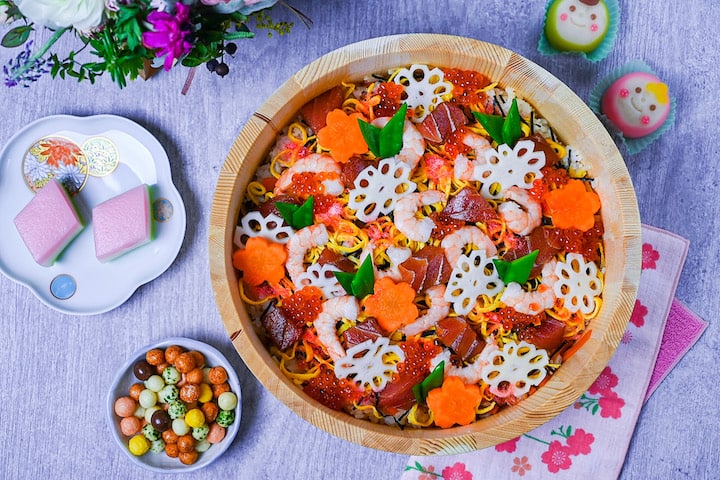
FAQ
The sushi named “chirashizushi” was originally just rice mixed with vinegar. Chirashizushi, as we know it today, used to be more commonly known as “barazushi.” In Japanese, “barabara” is the onomatopoeia for scattering.
These days, chirashizushi is known for its beautifully cut, high-quality ingredients and is popular to eat on special occasions. On the other hand, “barazushi” is a more humble dish made with cooked vegetables and less attractive, end pieces of the sashimi. Barazushi is common in home cooking and fish markets.
Scattered sushi dishes were born in the Edo period (1603-1868). Back then, sushi chefs were so busy with their work that they did not have time to enjoy proper sushi. They would scatter offcuts and end pieces of sashimi over the leftover rice, inventing a quick and easy meal for chefs.
Pick out some colorful ingredients that you like and that will make your dish look really good. Focus on making a bright color mix with red, green, and yellow for the best look.
Raw fish isn’t necessary for delicious chirashizushi! You can make equally delicious versions using cooked seafood options such as boiled prawns, steamed scallops, smoked salmon, or even crab sticks.
The key to visually stunning chirashizushi is thoughtful presentation. Use decorative molds or cookie cutters to create interesting shapes from vegetables. Pick ingredients with rich, vibrant colors and arrange them with attention to contrasting textures and complementary hues.
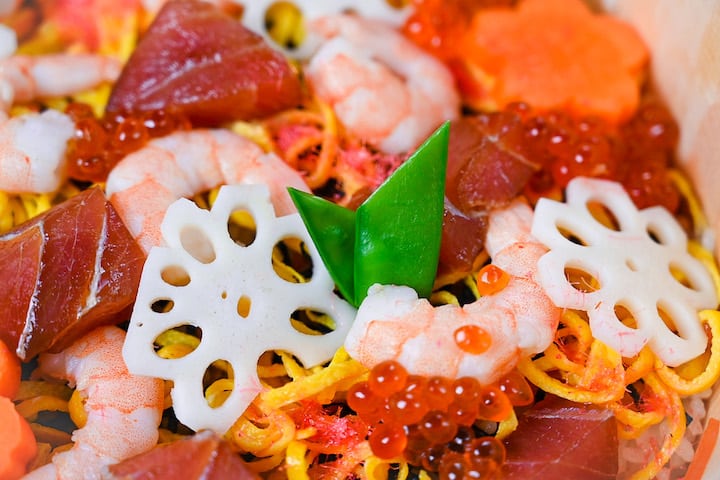
I hope you enjoy this Chirashizushi recipe! If you try it out, I’d really appreciate it if you could spare a moment to let me know what you thought by giving a review and star rating in the comments below. It’s also helpful to share any adjustments you made to the recipe with our other readers. Thank you!
More Japanese Sushi Recipes
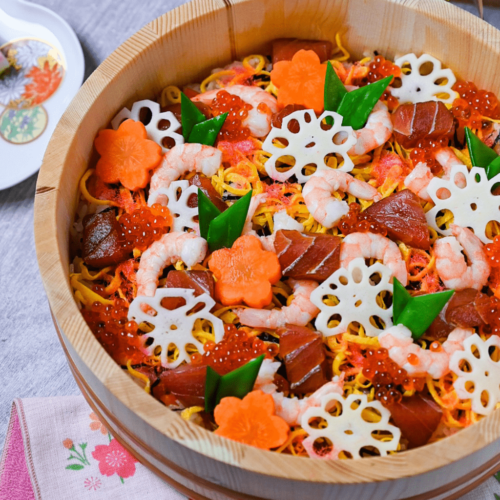
Chirashizushi (Scattered Sushi Bowl)
Equipment
Ingredients
Rice
- 3 dried shiitake mushroom or 2 medium/1 large
- 200 ml cold water
- 1 carrot (medium size) julienned or decoratively cut
- 30 g fried tofu pouch (aburaage) thinly sliced
- 1 tbsp sake
- 2 tbsp mirin
- 1 tbsp sugar
- 2 tbsp Japanese soy sauce (koikuchi shoyu)
- 2 tbsp rice vinegar
- 1 tbsp sugar
- ½ tbsp salt
- 660 g cooked Japanese short-grain rice
Tuna and Marinade
- 1 tbsp sake
- 1 tbsp mirin
- 1 tbsp Japanese soy sauce (koikuchi shoyu)
- 75 g sashimi grade tuna cubed
Kinshi Tamago
- 2 eggs
- 2 pinches salt
- 1 tsp cooking oil
Other toppings
- 25 g lotus root (renkon) sliced and boiled
- 100 g shrimp deshelled and boiled
- 15 g marinated salmon roe (ikura)
- 2 tbsp sweet pink fish powder (sakura denbu) optional
- 10 snow peas blanched and cut in half diagonally
- 3 tbsp kizami nori (shredded nori)
My recommended brands of ingredients and seasonings can be found in my Japanese pantry guide.
Can’t find certain Japanese ingredients? See my substitution guide here.
Instructions
Prep (soaking / marinating)
- Tip: I recommend soaking your rice before you start this recipe, 30 minutes (or 1 hour in winter).

- Start by soaking 3 dried shiitake mushroom in 200 ml cold water until rehydrated (about 30 minutes).

- Next, make the marinade for the tuna. Take a small saucepan and add 1 tbsp sake and 1 tbsp mirin. Boil for 30 seconds to remove the alcohol, and then turn off the heat.

- Add 1 tbsp Japanese soy sauce (koikuchi shoyu) to the pan and mix. Allow to cool for a few minutes.

- Once cool enough to touch, place the cubed 75 g sashimi grade tuna into a container and pour the sauce over it. Mix well, cover, and marinate in the fridge until serving time.

- Use this soaking/marinating time to prepare all of your toppings according to the ingredients list. You can also use this time to cook your rice either in a pot or in a rice cooker.

Rice
- Once the mushrooms are rehydrated, the water becomes a concentrated shiitake dashi. Pour the dashi into a pan and squeeze the shiitake to release any excess liquid. Cut them into thin slices and add them to the pan along with 1 carrot and 30 g fried tofu pouch (aburaage) – also thinly sliced.

- Add 1 tbsp sake, 1 tbsp sugar, 2 tbsp mirin and 2 tbsp Japanese soy sauce (koikuchi shoyu). Mix well and cook over a medium heat until the liquid is gone. Mix occasionally to ensure the ingredients do not burn.

- Once the liquid is gone, remove the pan from the heat.

- In a small bowl, mix 2 tbsp rice vinegar, 1 tbsp sugar and ½ tbsp salt until dissolved. This is your homemade sushi vinegar.

- Pour the sushi vinegar over 660 g cooked Japanese short-grain rice (hot, freshly cooked) and mix thoroughly.

- Empty the contents of the pan into the rice and mix gently until evenly distributed, then cover with a damp kitchen towel to prevent the rice from drying out.

Kinshi Tamago
- Crack 2 eggs into a bowl with 2 pinches salt and whisk well.

- Pour the whisked egg through a sieve placed over another bowl and whisk until it passes through.

- Heat a small non-stick frying pan on a medium-low setting and add 1 tsp cooking oil. Use a paper towel to spread the oil around the pan and remove the excess. Keep the paper towel for later.

- Pour the whisked egg into the pan to create a thin layer. You will need to cook the kinshi tamago in batches to ensure it is not too thick (depending on the size of your pan).

- Lift the pan and swirl it around to spread the egg, then cook until the egg is 80% done (slightly soft on the surface). Lifting the pan off of the heat source occasionally will prevent it from browning.

- Peel the egg out of the pan, transfer it to a chopping board and roll it up. Thinly slice using a sharp knife to complete the kinshi tamago. Repeat these steps until all of the egg mixture is used.

Assembly
- Transfer the rice into the serving bowl(s) and sprinkle with 3 tbsp kizami nori (shredded nori).

- Spread the kinshi tamago over the top.

- Arrange the rest of your ingredients (25 g lotus root (renkon), 100 g shrimp, 15 g marinated salmon roe (ikura), 2 tbsp sweet pink fish powder (sakura denbu), 10 snow peas and marinated tuna) on top.

- Serve and enjoy!
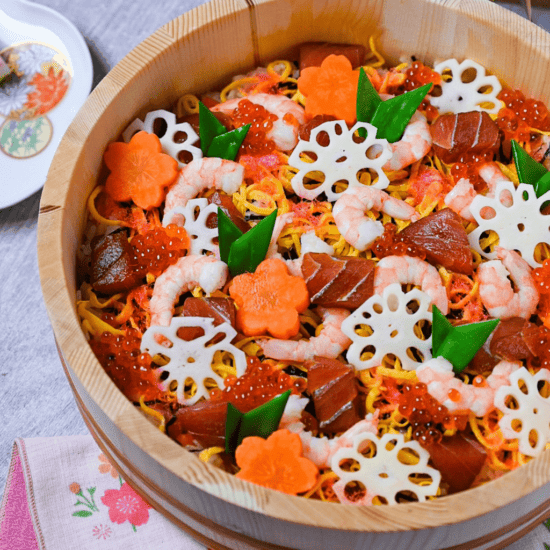




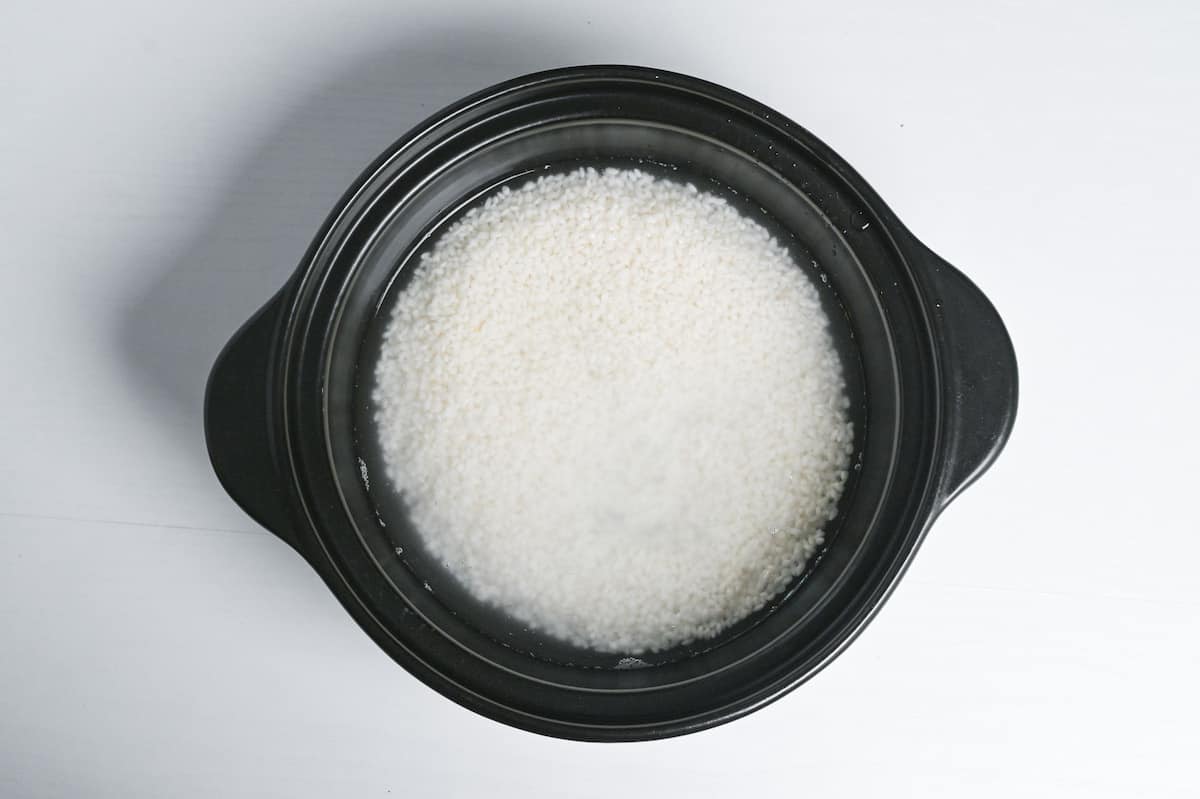
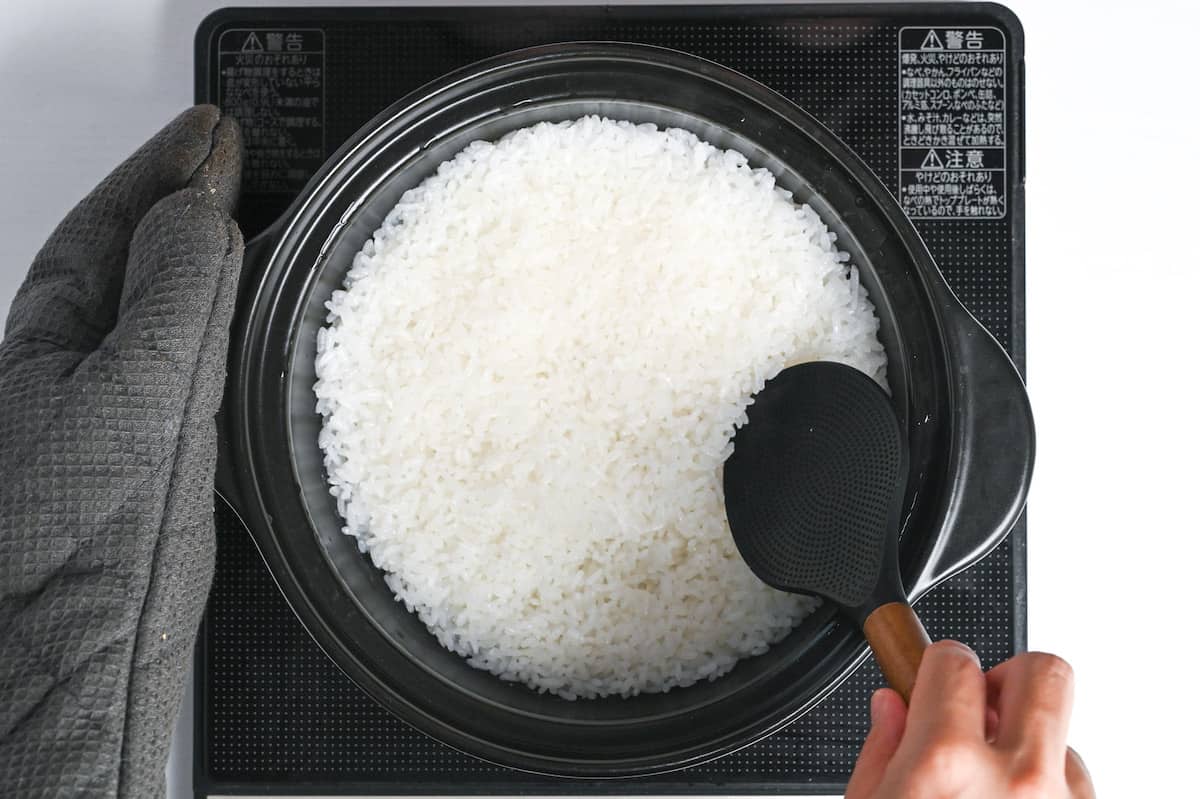
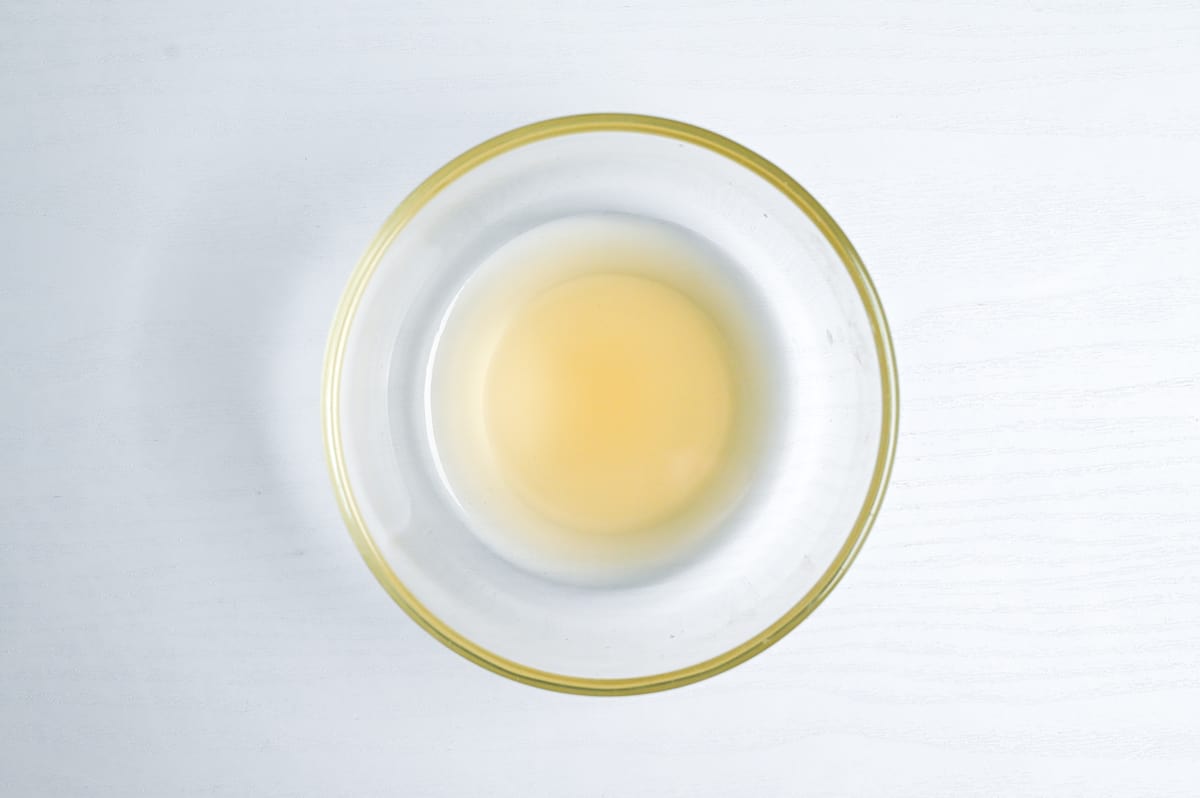
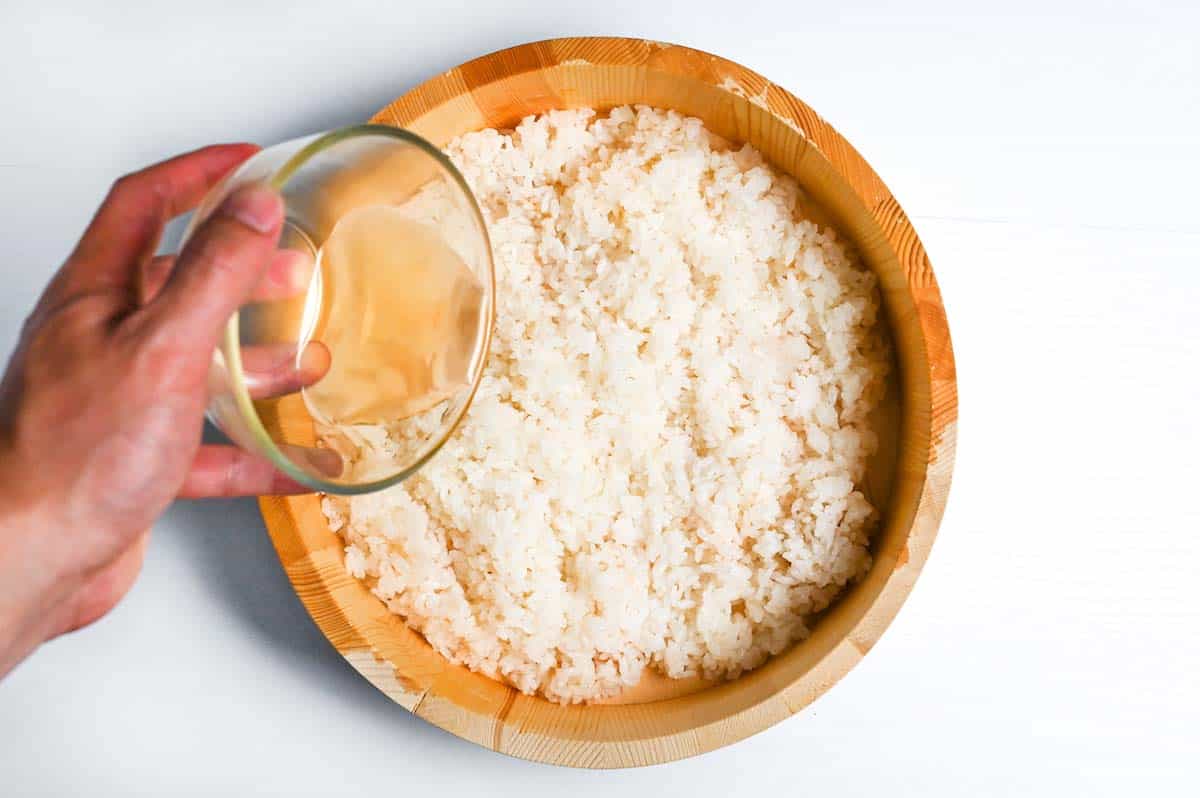
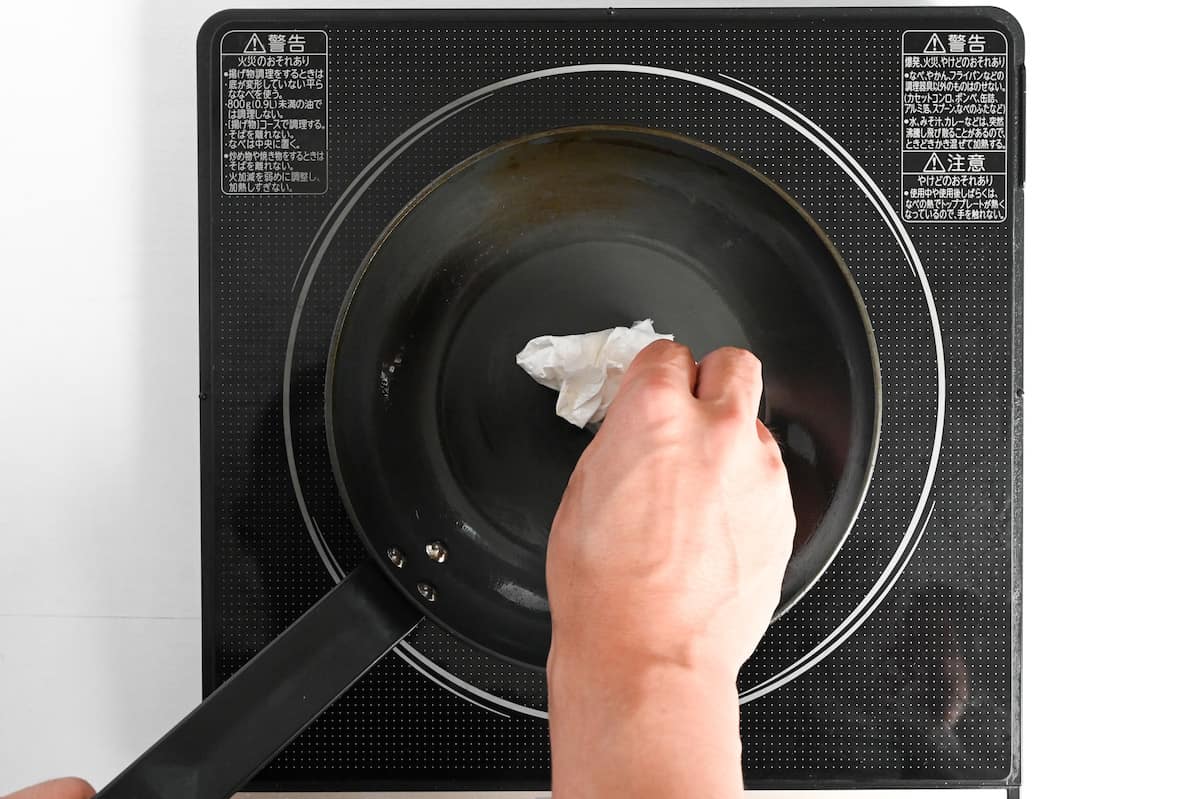
I’ve made this dish several times now and everyone’s enjoyed it a great deal. It’s delicious and a wonderful alternative to the usual fare.
Hi Ellen,
Thank you for trying this recipe and sharing your experience! I’m happy to hear you and your family/friends enjoyed it! 🙂
Yuto